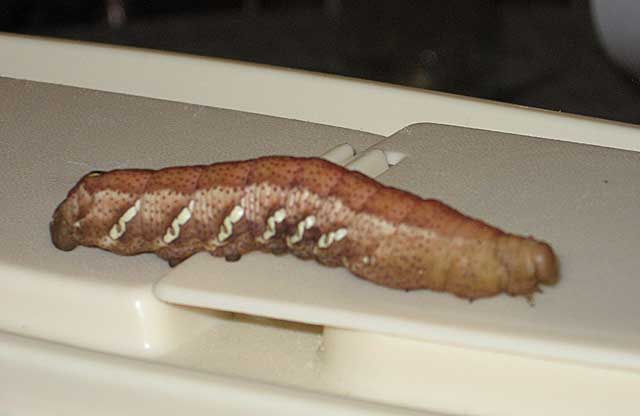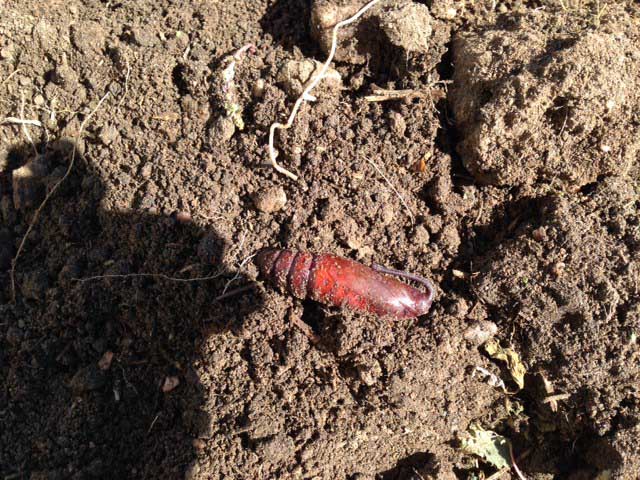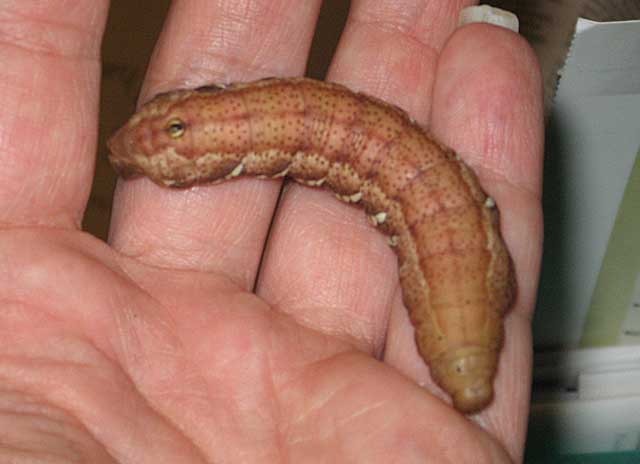Laramie County, Wyoming
Sphingidae Larvae

|
|
Created/dedicated as per personal communication with Cristina J. Sheats, Cheyenne, Wyoming, August 27, 2010 Updated as per James P. Tuttle's The Hawk Moths of North America, August 27, 2010 Updated as per Butterflies and Moths of North America, formerly USGS, August 27, 2010 Updated as per psersonal communication with Dawn Carroll (Manduca quinquemaculatus pupa; September 27, 2015); September 28, 2015 |

For care of "found larvae/caterpillars" visit Manduca sexta larva, central Texas, August 21, 2008, Trina Woodall.
This page is inspired by and dedicated to Cristina J. Sheats of Cheyenne, Laramie County, Wyoming,
for her interest in lepidoptera.
Cristina also provides the images of a Eumorpha achemon larva at top and bottom of this page, and she has confirmed Hyles lineata
in Laramie County.
Cristina writes, "We live in Cheyenne, Wyoming, North America. We found this guy crawling across some broken bricks near the parking lot at my children's
school today.
There were Four-O-Clocks about 5-6 ft from his location (across dirt and gravel) and another kind of plant in the other direction (same inbetween terrain),
but he doesn't seem interested in eating either of them. The Four-O-Clocks are looking a bit stressed because of their dry, sunny location (they are not
in a garden, but just "weeds" growing along a wall) but I don't know how much caterpillars care about that sort of thing.
"As you can see in the pictures he's relatively big... nearly 3 inches. His most distinctive features are the white squiggly slashes on his sides and
the "cat's eye" mark on his tail. As you can see in the picture, the "cat's eye" marking is flush with his skin, but it is hard like a little button.
We have found White-lined Sphinx Moth larva in these Four-O-Clocks in the past, but they've always been of the green or green and black varity. I've
searched every caterpillar site I can find, but no one has one - brown, hairless, white slashes, no protrusions - like him that I can find. I wondered if
that button could be a broken horn, but I can't even find one with a tail horn that matches his description.
I'll be glad to answer any questions that I can. We were hoping to make a habitat and keep him til he turns, but if we can't figure out what he is or what
he eats, that won't be possible. We are hoping you can help."
I already have created a Laramie County pictoral checklist for adult Sphingidae at
http://www.silkmoths.bizland.com/wyLaramiesph.htm.
I would like permission to post your images of Eumorpha achemon, credited to you, on a pictoral checklist I will create for Sphingidae larvae. You
can access more pictures and info from the link above."
Many thanks to Dawn Carroll who unearthed a Manduca pupa in a potato field in Hillsdale. It might be Manduca sexta, but I favour Manduca quinquemaculatus which has been documented as feeding on potato foliage.

Manduca quinquemaculatus pupa, Hillsdale, Laramie County, Wyoming,
September 27, 2015, courtesy of Dawn Carroll, tentative id by Bill Oehlke.
Sphinginae subfamily
Smerinthini Tribe:
Macroglossinae subfamilyDilophonotini Tribe
Philampelini Tribe:
Macroglossini Tribe
|

Enjoy some of nature's wonderments, giant silk moth cocoons. These cocoons are for sale winter and fall. Beautiful Saturniidae moths will emerge the following spring and summer. Read Actias luna rearing article. Additional online help available.
Eggs of many North American species are offered during the spring and summer. Occasionally summer Actias luna and summer Antheraea polyphemus cocoons are available. Shipping to US destinations is done from within the US.
Use your browser "Back" button to return to the previous page.
This page is brought to you by Bill Oehlke and the WLSS. Pages are on space rented from Bizland. If you would like to become a "Patron of the Sphingidae Site", contact Bill.
Please send sightings/images to Bill. I will do my best to respond to requests for identification help.
 Show appreciation for this site by clicking on flashing butterfly to the left. The link will take you to a page with links to many insect sites. |